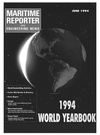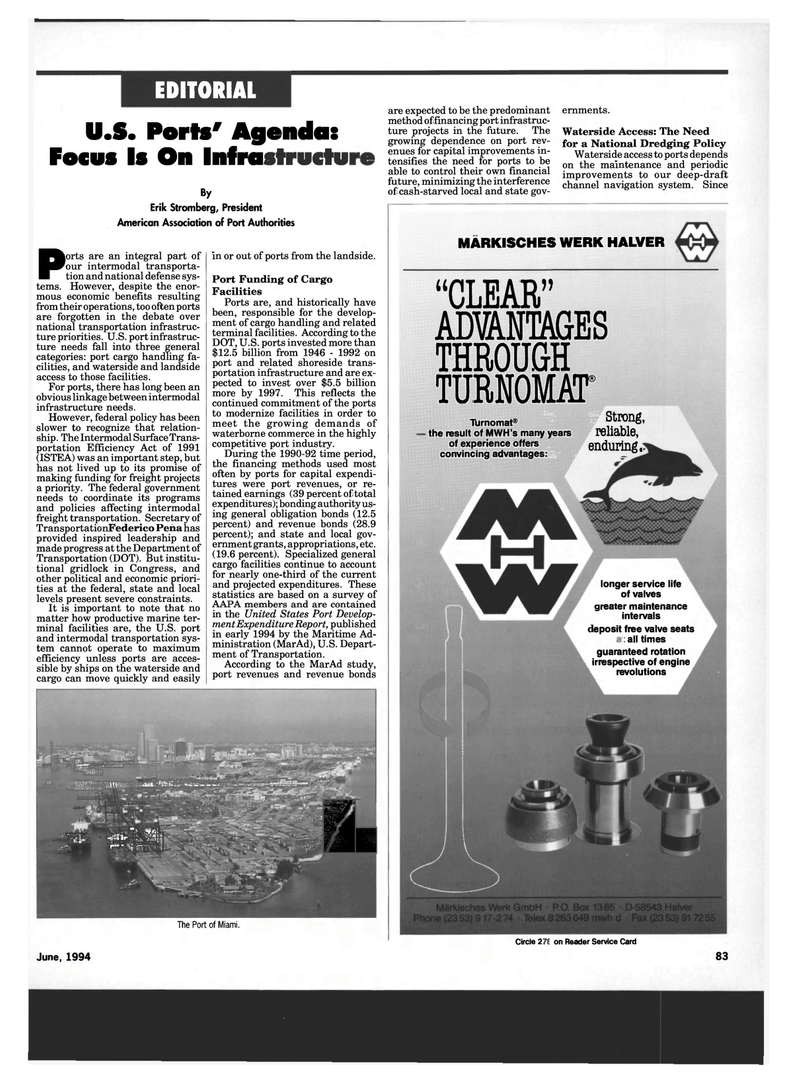
Page 73: of Maritime Reporter Magazine (June 1994)
Read this page in Pdf, Flash or Html5 edition of June 1994 Maritime Reporter Magazine
EDITORIAL
U.S* Ports' Agenda:
Focus Is On Infrastructi
By
Erik Stromberg, President
American Association of Port Authorities
Ports are an integral part of our intermodal transporta-tion and national defense sys- tems. However, despite the enor- mous economic benefits resulting from their operations, too often ports are forgotten in the debate over national transportation infrastruc- ture priorities. U.S. port infrastruc- ture needs fall into three general categories: port cargo handling fa- cilities, and waterside and landside access to those facilities.
For ports, there has long been an obvious linkage between intermodal infrastructure needs.
However, federal policy has been slower to recognize that relation- ship. The Intermodal Surface Trans- portation Efficiency Act of 1991 (ISTEA) was an important step, but has not lived up to its promise of making funding for freight projects a priority. The federal government needs to coordinate its programs and policies affecting intermodal freight transportation. Secretary of
TransportationFederico Pena has provided inspired leadership and made progress at the Department of
Transportation (DOT). But institu- tional gridlock in Congress, and other political and economic priori- ties at the federal, state and local levels present severe constraints.
It is important to note that no matter how productive marine ter- minal facilities are, the U.S. port and intermodal transportation sys- tem cannot operate to maximum efficiency unless ports are acces- sible by ships on the waterside and cargo can move quickly and easily
Isg - >aV*~: ; : -<•* - S? ~ - ^SrirjLlSlS r8"- | * I I*
The Port of Miami. are expected to be the predominant method of financing port infrastruc- ture projects in the future. The growing dependence on port rev- enues for capital improvements in- tensifies the need for ports to be able to control their own financial future, minimizing the interference of cash-starved local and state gov- ernments.
Waterside Access: The Need for a National Dredging Policy
Waterside access to ports depends on the maintenance and periodic improvements to our deep-draft channel navigation system. Since in or out of ports from the landside.
Port Funding of Cargo
Facilities
Ports are, and historically have been, responsible for the develop- ment of cargo handling and related terminal facilities. According to the
DOT, U.S. ports invested more than $12.5 billion from 1946 - 1992 on port and related shoreside trans- portation infrastructure and are ex- pected to invest over $5.5 billion more by 1997. This reflects the continued commitment of the ports to modernize facilities in order to meet the growing demands of waterborne commerce in the highly competitive port industry.
During the 1990-92 time period, the financing methods used most often by ports for capital expendi- tures were port revenues, or re- tained earnings (39 percent of total expenditures); bonding authority us- ing general obligation bonds (12.5 percent) and revenue bonds (28.9 percent); and state and local gov- ernment grants, appropriations, etc. (19.6 percent). Specialized general cargo facilities continue to account for nearly one-third of the current and projected expenditures. These statistics are based on a survey of
AAPA members and are contained in the United States Port Develop- ment Expenditure Report, published in early 1994 by the Maritime Ad- ministration (MarAd), U.S. Depart- ment of Transportation.
According to the MarAd study, port revenues and revenue bonds
MARKISCHES WERK HALVER
Circle 332 on Reader Service Card
June, 1994 83 "CLEAR" ADVWIAGES
THROUGH TURNOMAT
Turnomat® Strong, the result of MWH's many years reliable, of experience offers enduring convincing advantages: 51 longer service life of valves greater maintenance intervals deposit free valve seats : all times guaranteed rotation irrespective of engine revolutions

 72
72

 74
74
